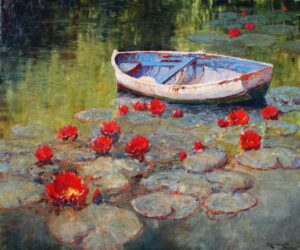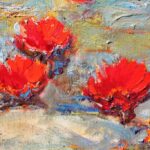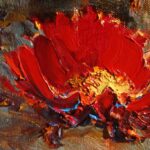
I always use a very high quality, pre-primed, heavy-duty linen canvas by a leading manufacturer. I also choose a very coarse linen. Why? When observed very closely, the surface of such canvas is a series of round bumps linear in both directions.
Once I have suggested the drawing, or perhaps more correctly the positioning of my masses, I like to color the canvas with a wash of chosen color. I never use pure turpentine, only because it denies any body in the pigment in places on the canvas where no other paint will cover this wash which, without the addition of oil, will not survive time.
At this point in the procedure, I have no white or opaque colors on my palette. The result is an effect as pure in color as a watercolor on white paper. Often the most gorgeous colors are dark and intense. Here I might bypass the wash and apply the pigment without medium. Then because I require a lift in the tone or lightness of an area, I use a knife to scrape off most of the paint. Now because the canvas has all its multiple mini-projectories, the paint will be left only in the recesses of the canvas. So, actually what happens is that the white of the canvas bumps is seen through the applied pigment. From very close, it appears spotty, but from afar, the eye reads a lighter value of a delightful dark pigment which has in no way lost its transparency or luminosity. Also because the paint is so recessed in the canvas texture, one can apply either a scumble or impasto without drying time.
At this point, I normally choose to scumble, also because being so thin and adhering to the canvas projectories only it will harden quickly. Until I really have my picture talking to me, I don’t choose to paint wet in wet.
What I’m describing is more for large canvasses in one’s studio. Plein air small works don’t belong to this category. Small plein air, one tends to go in fully loaded. There is too much wind and way too many bugs to do anything else.

Scumbling, a very light touch to the canvas with a large flat brush using undiluted paint, will offer numerous effects but never totally cover the wash or the scratched areas. Otherwise, why bother to put them in, in the first place. Every stage is part of the finished painting.
Now comes the impasto. For some reason or another, lumpy paintings have become the vogue. The idea of a lump on a canvas is that under angular lighting, a lump will catch the beam of light and visually leap off the canvas. Now this is great for highlights in high-toned colors. If the painting is ultimately varnished, your lumps will “shine” as well under spotlights. If you don’t want shine or glitter, don’t lump. Lumps in a dark area glisten and totally destroy the intensity of the dark. Recently, I saw a show where the whole painting was lumps. Wonderful for the manufacturer but a disaster to the painting – and the viewer!

Painting florals is interesting. A knife is good, but it tends to lose the delicacy and femininity of a petal. As petals of a rose, for example, are so perfect a non-textural finish is needed. No shadows are required in a petal under the sun. A brush stroke will leave fiber striations, which cast minute shadows. A latex gloved finger will give you a petal beyond your expectations. But use a new finger for every application. Otherwise, you will have the most devastating mud pie!
There is no need at any stage of a painting to apply any pigment which will not be seen in the finished work. One can, of course, rub color over another color to create a secondary value – but let’s not get too complicated!